Following on from last week’s article “Elizabeth I – Queen of PR”, I thought it would be good to start our examination of Elizabeth I portraits with the famous Armada portrait. This portrait is by an unknown artist (possibly George Gower) and was painted circa 1588, the same year as Elizabeth I’s defeat of the Spanish Armada.
The Armada Portrait is rich in symbolism, as are many of Elizabeth’s portraits, so I’ll start the ball rolling with symbols I can see and have found during my research, but please do add your own thoughts in the comments section below.
Symbolism in the Armada Portrait
- Pearls – Like her mother before her, Elizabeth loved pearls and in her portraits pearls symbolise purity and virginity. Pearls symbolised purity. Marilee Cody, on her excellent site on Tudor portraits – http://www.marileecody.com/eliz1-images.html – suggests that the pearls were Dudley’s last gift to Elizabeth and so had special meaning to Elizabeth.
- Elizabeth – Although Elizabeth was around 55 when this portrait was painted, she is presented as youthful and vibrant with her made-up face, bright red hair and unblemished complexion. She is also dressed in all her finery and rich jewels, and really is the iconic, ever-youthful Virgin Queen.
- Elizabeth’s gaze – C J Cairns writes of how the way that she is gazing into the distance could symbolise her looking to the future of her realm.
- Posture – Just as her father liked his posture to speak of his power and magnificence, Elizabeth too has adopted a posture of power.
- Ruff – C J Cairns writes of how her ruff frames her face like rays of the sun.
- Window scenes – I think it was David Dimbleby in his series “The Seven Ages of Britain” who noted that in the window on the left hand side of the painting there is the arrival of the Armada and then on the right there is the defeat of the Armada. This portrait could be seen as a tribute to Elizabeth’s success at protecting the nation from Spanish invasion or you could see a religious meaning: perhaps the ships are being forced onto the rocks by the “Protestant wind”. C J Cairns comments that Elizabeth has “called upon the elements to dispel the Spanish Catholic threat”.
- Globe – If you look at the placement of Elizabeth’s hand on the globe, you can see that her hand is over the Americas which England was busy colonising. As Marilee Cody points out, this painting was painted one year after the birth of the first English child in the colonist’s settlement of Virginia. Her fingers are extending to other parts of the globe and this symbolises that Elizabeth’s power is fa reaching and that the whole world is at her disposal.
- Pillars – An article on wikipedia says that “The Queen is flanked by two columns behind, probably a reference to the famous impresa of the Holy Roman Emperor, Charles V, Philip II of Spain’s father, which represented the pillars of Hercules, gateway to the Atlantic Ocean and the New World.”
- The egg shaped object – Of you look at the right hand side of the painting, you can see that there is an egg shaped object above Elizabeth’s shoulder and in front of the window. It appears to be a pomegranate which symbolised fertility, abundance, generosity, union, prosperity, rebirth, resurrection and eternal life.
- The Crown – Confirmation of Elizabeth’s powerful position as monarchy and her royalty and majesty. If it is indeed an imperial crown, as some have suggested, it speaks again of Elizabeth’s far reach and Elizabeth as Empress.
- Carving – The arm of the chair has a carving of a mermaid which, according to C J Cairns was “a symbol of the potential destructive nature of females” and that Elizabeth’s position with her back to the image could signify her rejection of its meaning. I wonder if it actually speaks of Elizabeth’s power over the seas.
- Bow – One article on this portrait has suggested that the placement of the large bow is a “blatant display of Elizabeth’s virginity” just as Henry VIII’s large codpiece spoke of his sexuality and prowess.
Notes and Sources
- Elizabeth I: The Armada Portrait by C J Cairns
- Portraits of Queen ELizabeth I, by Marilee Cody
- Portraiture of Elizabeth I of England
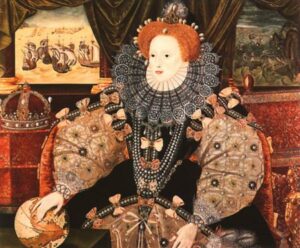
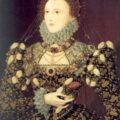
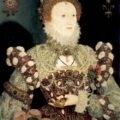

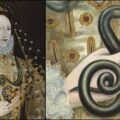
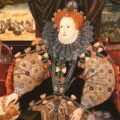
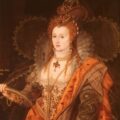
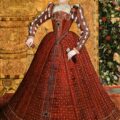
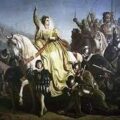
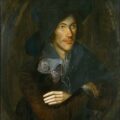
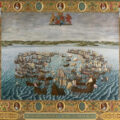

I really love this website! The information is similar to my curriculum and ties in with my syllabus. Its thorough explanations and reasoning helped me lots for my A – levels!
The pomegranate near the crashing Spanish ships could also represent Spain. The pomegranate was Catherine of Aragon’s symbol, and she was Philip II’s great aunt.
the portraits representing the spanish armarda
i have history homework and there´s an arrow pointing at the sleeve i need to explain the meaning of it… can anyine help?
We know what that mermaid symbol means. Pearls are mermaid code for those in the know. You are one of the few who has an inkling about the Tudor Rose. Did you know Mary Magdalene was a redhead ?
It’s hard to tell if it’s a pomegranite. It could and previous ideas hold good. However IF it is an egg, the implications are rather more interesting. With the age and colour fading of the painting, not easy to say if the egg could be red. IF it was a red egg, the implications of that are even more interesting. A red egg points right to Mary Magdalene. Mary was red headed and also linked to the mermaid legend, as was Mary Queen of Scots. Previous posts are correct, mermaid was slang for prostitute in some quarters. But there is more to this, some think they had real mermaid blood.
In some paintings Elizabeth Tudor is linked to the red rose, or Tudor Rose. The rose links
Elizabeth to either the Virgin Mary, or Mary Magdalene. There were rumors Liz never let a doctor or her maids see her fully naked. Some rumors claim she was a man, and the ruff covered an adams apples, and the white painted face also hid things. However the Sea Masons and The Cafuelarena claim that she was to some extent, hermaphrodite, and obviously a virgin. As are mermaids.
It would have been odd, not to say risky to put a mermaid on the chair, if there were not some pressing desire to acknowledge, or signify mermaid credentials. To the ignorant, mermaid meant prostitute. Who on earth would put a prostitute on their chair, unless it was alluding to some deeper secret ? True, the mermaid “could” have been an allusion to Mary Queen of Scots, but why when Liz was trying unite and unify her country ?
Liz hardly gloated over Marys death, she was distressed by it, and wouldn’t want a reminder of it.
If Liz was a red headed hermaphrodite virgin, mermaid stock, like Mary Magdalene, and distantly related to Magdalene, the mermaid symbol would be there for obvious reasons.
To some, it would have been an insult if there was no mermaid.
O.k just had look at the links, and done close ups of the pomegranite or egg. The closer you look, the less it looks like a pomegranite. In one of the links it is either a red egg, or it could be a knob part of the furniture, as another post suggests. If it is a red egg, it is a big if, but if it is a red egg, well to place a red egg in painting with a mermaid, is almost as explosive as Disney putting a painting of Mary Magdalene at the bottom of the ocean in a film about a red headed mermaid called “Ariel”. Magdalene means elevated in Greek.
A red egg and a mermaid in picture with Elizabeth Tudor, calling herself the virgin Queen,
rumored to be hermaphrodite, could hardly be more blatant for those with eyes to see.
The pillars of Hercules “could” be a reference to Atlantis, again linked to the mermaid legend. Atlantis is now known as Santorini, off Crete. It was destroyed by an ancient tsumami.
Hi, I would like to read one of your sources: Elizabeth I: The Armada Portrait by C J Cairns”
but I can’t find it anywhere and if I click it, it does not work. Could you please give me a link or tell me where did you find the information? Thank you
Hi Cristina,
Unfortunately, since I wrote my article in 2010 the C J Cairns article has been take offline ad I don’t have a copy of it I’m afraid. Sorry about that.